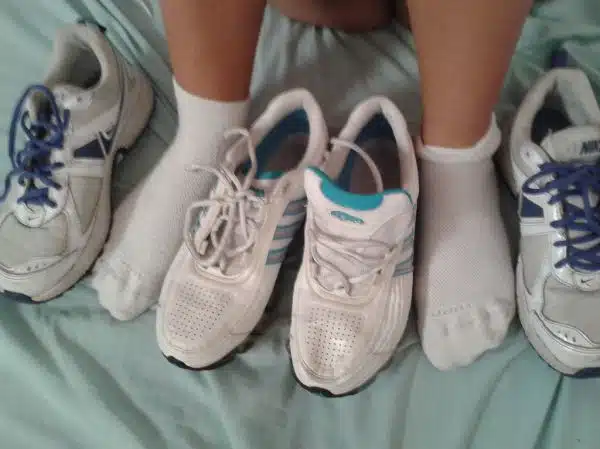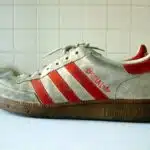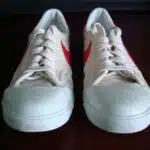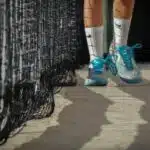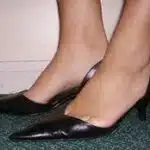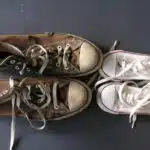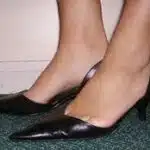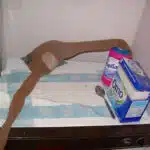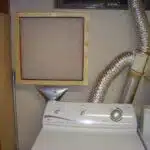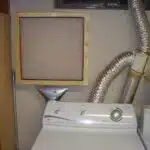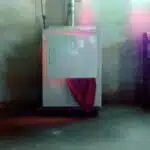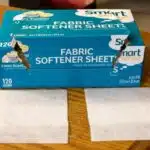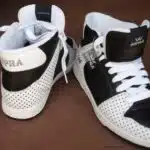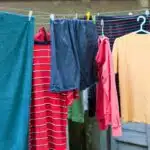As a laundry care expert, it is important to know the proper techniques for drying sneakers in a dryer. Sneakers are often made of materials that can be sensitive to high heat or tumbling, which can result in shrinkage, damage or loss of shape. Improperly dried sneakers may also emit an unpleasant odor and have a shorter lifespan.
To ensure that your sneakers are properly dried without damaging them or reducing their quality, it is important to follow some key steps. In this article, we will explore the best practices for drying sneakers in the dryer, including how to prepare your sneakers before placing them in the dryer and what settings to use. By following these guidelines, you can keep your sneakers looking and smelling great while extending their lifespan.
Preparing Your Sneakers For Drying
Did you know that the average person walks over 100,000 miles in their lifetime? With so much wear and tear on our feet, choosing proper footwear is crucial to maintaining healthy feet. When it comes to drying your sneakers, it is important to prepare them properly. Before tossing them in the dryer, make sure to remove any excess dirt or debris from the surface of the shoe.
Additionally, pre-treating any stains before drying can help prevent discoloration or damage to the fabric. Use a gentle stain remover and follow the instructions carefully. Once you have cleaned your sneakers and treated any stains, it is time to move on to removing excess moisture.
By taking these simple steps before drying your sneakers in the dryer, you can ensure that they will come out looking clean and fresh without any damage to the material. Keep reading for more tips on how to correctly dry your sneakers in the dryer by removing excess moisture.
Removing Excess Moisture
After preparing your sneakers for drying, it’s time to focus on removing excess moisture effectively. The first step in this process is to use a clean, dry towel to blot the surface of your sneakers. This will help absorb any remaining moisture in and around the shoe. It’s important to avoid rubbing or pressing too hard, as this can cause damage to the material.
Once you’ve removed as much moisture as possible with a towel, consider using effective moisture removal techniques such as placing crumpled newspaper inside each sneaker or using a shoe dryer. These methods draw out the remaining moisture from inside the shoe and help speed up the drying process. However, be cautious when using heat-based drying methods like a dryer or heater, as they can cause damage if used improperly.
Preventing damage from excess moisture is crucial in maintaining the quality and longevity of your sneakers. If left untreated, excess moisture can lead to mold growth or weaken adhesive materials used in construction. To prevent this from happening, make sure to thoroughly dry your sneakers before storing them away and avoid wearing them in wet conditions whenever possible.
When checking for loose or damaged parts after drying your sneakers, it’s important to do so carefully and with a keen eye. Look for any signs of wear and tear that may have been caused by excess moisture during the drying process. By taking these steps, you’ll be able to keep your sneakers looking and feeling their best for years to come.
Checking For Loose Or Damaged Parts
It is important to check for loose or damaged parts on sneakers before putting them in the dryer. This can prevent further damage and make sure they are properly dried. One way to identify wear and tear is to look at the soles of the shoes. If they are worn down, it may be time to replace them or have them repaired. Additionally, inspecting the stitching and any other areas prone to wear and tear can help identify any potential issues.
If any loose or damaged parts are found on the sneakers, it is best to repair them before drying. Loose stitching or tears in the fabric can become worse during the drying process, resulting in irreparable damage. It is recommended to use a strong adhesive or needle and thread to fix any issues. However, if there are significant damages such as a broken sole or major hole, it may be better to take them to a professional cobbler for repair.
By taking the time to check for loose or damaged parts on sneakers before putting them in the dryer, you can prevent further damage and ensure they are properly dried. Repairing any issues beforehand can also prolong the life of your shoes. In the next section, we will discuss how choosing the right dryer settings can also help maintain your sneakers’ quality over time.
Choosing The Right Dryer Settings
After checking for any loose or damaged parts, it is essential to choose the right dryer settings when drying your sneakers. This not only ensures that your sneakers dry correctly but also prevents potential risks such as lint buildup and fire hazards. When selecting the dryer settings, there are two essential factors to consider: energy efficiency and noise level.
Energy efficiency is a crucial factor to consider when drying sneakers in the dryer. To save on energy consumption, it is recommended that you use the low heat setting instead of high heat. High heat settings tend to consume more energy and can cause damage to your sneakers, making them shrink or even melt. Using the low heat setting will take longer for your sneakers to dry, but it will ensure they are not damaged and save on energy costs.
Another essential factor to consider when choosing the right dryer settings is noise level. Drying sneakers can be noisy in some cases, especially if you are using a high heat setting or an old dryer with a loud motor. If you live in an apartment complex or share a living space with others, this could cause disturbance or annoyance. It is recommended that you use a newer model of the dryer with a soundproofing feature or place rubber pads under the dryer feet to reduce noise levels.
Using a low heat setting is one of the best ways to dry your sneakers without causing any damage while saving on energy costs. It is important to note that using high heat can lead to lint buildup and fire hazards due to overheating materials inside the dryer. In the next section, we will discuss how using a low heat setting can prevent these potential risks while still ensuring that your sneakers dry correctly.
Using A Low Heat Setting
When it comes to drying sneakers in the dryer, using a low heat setting is crucial to prevent damage to the shoes. While high heat may seem like a faster and more efficient option, it can cause shrinkage, discoloration, and even melted glue on the shoes. Therefore, taking the time to dry your sneakers on a low heat setting will not only preserve their appearance but also extend their lifespan.
One of the benefits of air-drying your sneakers is that it eliminates any risk of damage from excessive heat exposure. Not only that, but air drying is also an affordable and eco-friendly alternative to using the dryer. Simply place your shoes in a well-ventilated area away from direct sunlight or heaters and let them dry naturally. This method may take longer than using a dryer, but it’s worth it for the added protection and sustainability benefits.
If you prefer not to air-dry your sneakers or don’t have access to a well-ventilated area, there are alternatives to using the dryer’s high heat setting. One option is to use a medium or low heat setting instead. While this may increase drying time slightly, it will still provide enough warmth for moisture removal without causing damage to your shoes. Another alternative is to use specialized shoe-drying products such as sneaker balls or inserts that absorb moisture and speed up drying time while protecting your shoes from excessive heat exposure.
To avoid damaging your sneakers in the dryer altogether, another step you can take is avoiding high heat settings completely. Instead, opt for low or medium heat settings and be patient with the drying process. Although it may take longer, using lower temperatures will ensure that your shoes remain intact and looking good as new.
Avoiding High Heat Settings
- Air drying is the safest option for sneakers, as the high heat setting of a dryer may cause damage to the shoe’s materials.
- When using a dryer, it is recommended to set the temperature to low heat.
- If the temperature is too high, it may cause shrinkage, fading, and potential melting of materials.
- It is also recommended that sneakers be placed in a mesh laundry bag for additional protection during the drying process.
- Placing a few clean tennis balls in the laundry bag with the sneakers can help to separate and fluff the material, resulting in a more even drying process.
- Lastly, it is best to remove the sneakers from the dryer as soon as the drying cycle is complete to prevent further heat damage.
Air Dry
The benefits of air drying sneakers are numerous. First and foremost, it is the gentlest option for your shoes. High heat can cause damage to the material and structure of your sneakers, whereas air drying allows them to dry naturally without any added stress. Additionally, air drying helps to preserve the color and shape of your shoes, making them last longer and look better over time.
If you don’t have the time or patience for air drying, there are alternative methods that are still gentler than using high heat in the dryer. One option is to use a low heat setting on your dryer, which will take longer but still minimize the risk of damage. Another alternative is to stuff your shoes with newspaper or paper towels and let them sit out in a well-ventilated area until dry. This method also helps maintain the shape of your shoes while allowing them to dry naturally.
In conclusion, while high heat settings may seem like a quick fix for drying sneakers, they can actually do more harm than good. By opting for air drying or gentler alternatives, you can ensure that your shoes remain intact and looking their best for longer periods of time. Remember: taking care of your sneakers will not only save you money in the long run but also keep you looking stylish from head to toe!
Low Heat Settings
When it comes to drying sneakers, high heat settings can be damaging to the materials and structure of the shoes. However, there are alternative methods that are gentler on your sneakers. One such option is using low heat settings in the dryer. While it may take longer for your sneakers to dry, this method will minimize the risk of damage to the materials and structure.
Low heat settings can be particularly useful for sneakers made from delicate materials such as leather or suede. These materials are more susceptible to damage from high heat, which can cause them to warp or lose their shape. By opting for low heat settings, you can ensure that your sneakers remain intact and looking their best.
In addition to low heat settings, another alternative drying method is stuffing your shoes with newspaper or paper towels and allowing them to air dry in a well-ventilated area. This method helps maintain the shape of your shoes while allowing them to dry naturally without added stress or damage from high heat. Ultimately, by utilizing gentle drying methods like low heat settings or air drying with paper products, you can extend the life of your sneakers and keep them looking their best for years to come.
Heat Damage Prevention
Preventing heat damage is a crucial aspect of maintaining the quality and longevity of your sneakers. Excessive heat can cause shrinkage, warping, and cracking in the materials of your shoes, which can lead to irreparable damage. As a laundry care expert, I recommend avoiding high heat settings when drying your sneakers to prevent such damage.
One effective method for avoiding shrinkage and other forms of heat damage is to use low heat settings on your dryer. By using this method, you are minimizing the risk of damaging the materials and structure of your sneakers while still achieving the desired level of dryness. This technique is particularly useful for delicate materials like leather or suede that require gentle handling.
Another way to prevent heat damage is by air-drying your shoes instead of using a dryer altogether. Stuffing your shoes with newspaper or paper towels helps maintain their shape as they dry naturally in a well-ventilated area. This method not only prevents heat damage but also allows for longer-lasting wear from your sneakers. By taking these precautions, you can ensure that your sneakers remain in excellent condition while prolonging their lifespan without sacrificing quality.
Using A Delicate Cycle
As the saying goes, “slow and steady wins the race.” This is particularly true when it comes to drying your sneakers in the dryer. Using a delicate cycle may take longer, but it is worth it in the end.
The benefits of using a delicate cycle are numerous. For one, it ensures that your sneakers will not get damaged or misshapen during the drying process. The gentle tumbling action of the delicate cycle helps to evenly distribute heat throughout each sneaker, preventing any hot spots from forming. This reduces the risk of scorching or melting any parts of your sneakers.
If you do not have access to a delicate cycle on your dryer, there are still alternatives available to you. One option is to use a low-heat setting and simply let your sneakers tumble for a longer period of time. Another option is to stuff your sneakers with towels or other absorbent materials before placing them in the dryer. This helps to absorb excess moisture and speed up the drying process without causing damage to your sneakers.
Now that you understand the benefits of using a delicate cycle and some alternative methods, it’s important to avoid overloading your dryer altogether. Doing so can lead to uneven drying and potential damage to both your sneakers and your dryer. In the next section, we’ll explore some tips for avoiding this common mistake while still achieving perfectly dry sneakers every time.
Avoiding Overloading The Dryer
Tips for Avoiding Overloading the Dryer
It is important to properly load your dryer to avoid damaging your sneakers or the machine itself. One common mistake people make is overloading the dryer with too many items at once. This can lead to uneven drying and damage to the machine’s motor. To avoid this, only load a few pairs of sneakers at a time and leave enough space between them for proper air circulation.
Another tip for avoiding overloading the dryer is to use a low heat setting. High heat can cause shrinking, warping or melting of shoe materials, such as rubber soles or synthetic fabric. A low heat setting will help preserve the integrity of your sneakers while still effectively removing moisture. It may take longer than high heat, but it is worth it in order to protect your footwear investment.
Finally, it is important to periodically check on your sneakers in the dryer to ensure they are not overheating or becoming damaged in any way. If you notice any issues, stop the cycle immediately and adjust accordingly. By following these tips and avoiding common mistakes, you can safely dry your sneakers in the dryer without causing any harm.
Transition: Now that we have covered how to avoid overloading your dryer, let’s move on to adding dryer balls or towels for optimal drying results.
Adding Dryer Balls Or Towels
When drying sneakers in the dryer, adding dryer balls or towels can be a useful technique to speed up the process and improve the overall results. While some people may prefer using dryer sheets, these products can contain chemicals that can damage the shoes over time. Instead, using dryer balls or towels is a safer and more efficient way to dry sneakers.
Dryer balls are designed to help separate fabrics during the drying cycle, allowing warm air to circulate more efficiently around them. When drying sneakers, it is recommended to use at least two dryer balls per load to ensure that they bounce around freely and do not get stuck in one place. Another great alternative is using towels instead of dryer balls. Towels also help create space between items in the load while absorbing excess moisture.
When comparing dryer balls to towels for drying sneakers, there are pros and cons to each method. Dryer balls tend to be more durable and longer-lasting than towels, which can become worn out over time. However, towels are generally softer and gentler on delicate materials like leather or suede. Ultimately, it comes down to personal preference and what works best for your specific type of sneaker.
Transition: Now that you know how adding dryer balls or towels can improve your drying results, the next step is checking progress during the drying cycle.
Checking Progress During The Drying Cycle
Adding dryer balls or towels to your drying cycle can help speed up the process and prevent your sneakers from getting damaged. However, it is important to monitor the drying process to ensure that they do not overheat or become misshapen. Did you know that according to a survey conducted by the American Cleaning Institute, 63% of people admit to using a clothes dryer for their shoes? With such a high number of people utilizing this method, it’s essential to know how to properly monitor the drying cycle.
Tips for monitoring include setting a timer for shorter increments, so you can check on the sneakers more frequently. If you notice any signs of overheating, such as unusual smells or excess heat emanating from the dryer, immediately stop the cycle and allow the sneakers to cool down before resuming. Additionally, if your sneakers have any embellishments or delicate materials, consider removing them before placing them in the dryer to avoid damage.
Troubleshooting techniques may be necessary if your sneakers are still damp after a full drying cycle. Try adding more dryer balls or towels to increase air circulation and absorb moisture. If this doesn’t work, extend the drying time by 10-15 minutes and check again. You may also want to consider removing any insoles or inserts from your sneakers during the drying process as these can retain moisture.
Now that your sneakers are dry, it’s time to remove them from the dryer without causing any damage. Avoid pulling on any laces or straps as this can cause tearing or stretching. Instead, gently remove each shoe from the drum and inspect them thoroughly for any signs of damage or discoloration. With these tips in mind, you’ll be able to safely dry your sneakers in no time!
Removing Sneakers From The Dryer
- It is important to be aware of the estimated drying time when drying sneakers in the dryer.
- To reduce the chance of damage, the laces should be removed prior to drying.
- It is also important to set the dryer on a low heat setting to prevent the sneaker fabric from shrinking or becoming misshapen.
- Additionally, sneakers should be placed in a small, mesh laundry bag prior to being placed in the dryer.
Drying Time
As a laundry care expert, it is important to understand the factors affecting drying time when it comes to removing sneakers from the dryer. One of the most significant factors is the material of the sneakers themselves. For example, leather and suede materials take longer to dry than synthetic materials due to their ability to retain water. Additionally, the size and thickness of the sneaker can also impact drying time.
If you are looking for tips on speeding up drying time for your sneakers in the dryer, there are several methods that can be tried. The first tip is to remove any excess moisture from the sneakers before placing them in the dryer. This can be done by using a towel or paper towel to absorb any water on or inside the sneaker. Another option is to add a dry towel or two into the dryer with your sneakers as this will help absorb moisture and speed up drying time.
Ultimately, understanding how long it takes for your particular sneakers to dry in the dryer will depend on various factors such as material and size. However, taking steps such as removing excess moisture and adding a dry towel can help speed up drying time significantly. As a laundry care expert, it is important to provide these tips for individuals who want to save time and ensure their sneakers come out of the dryer looking good as new.
Removing Laces
As a laundry care expert, it is essential to provide guidance on how to properly remove sneakers from the dryer. While material and size are significant factors in determining drying time, there are other steps that can be taken to ensure the best results. One of these steps is removing the laces before placing them in the dryer.
Cleaning laces can be a tedious task, but it is necessary if you want to keep your sneakers looking fresh and new. Laces can often become dirty or discolored from repeated wear, which can detract from the overall appearance of your sneakers. Before placing your sneakers in the dryer, it is recommended that you remove the laces and clean them separately. This will not only help prolong the life of your laces but also prevent any unwanted damage to your sneakers during the drying process.
Once you have removed and cleaned your laces, it is important to consider whether they need replacing altogether. If your laces are frayed or damaged beyond repair, it may be time to invest in a new set of laces. Not only will this improve the appearance of your sneakers, but it will also ensure that they stay securely fastened during wear. By taking these simple steps when removing sneakers from the dryer, you can ensure that they look their best for years to come.
Inspecting Sneakers For Damage
When it comes to caring for your sneakers, it is important to inspect them for any damages before drying them in the dryer. Common damages include tears, scratches, and scuffs on the surface of the shoe. These damages can lead to further problems in the future if not addressed promptly.
If you notice any damages on your sneakers, there are several repair options available. For minor damages such as scuffs or scratches, you can use a specialized shoe cleaner or polish to restore the appearance of the shoe. For more significant damages such as tears or holes, it may be necessary to take your sneakers to a professional cobbler for repair.
Ignoring damages on your sneakers can lead to more serious problems down the line. Not only can it affect the appearance of your shoes, but it can also compromise their structural integrity and affect their overall performance. Taking the time to inspect and address any damages before drying your sneakers in the dryer will ensure that they last longer and continue to look and perform their best.
As we have discussed, inspecting your sneakers for damage is an essential step in proper sneaker care. Once you have thoroughly inspected your shoes and addressed any damages that require attention, it is important to allow them adequate time to cool down before placing them in the dryer. This will prevent further damage from occurring during the drying process and ensure that your sneakers are ready for wear when you need them.
Allowing Sneakers To Cool Down
It is important to allow your sneakers to cool down after they have been dried in the dryer. According to a recent study, overheating shoes during drying can lead to damage and decreased lifespan of the shoe material. This is why proper ventilation during drying is crucial.
After removing your sneakers from the dryer, it is recommended that you let them sit in a well-ventilated area for at least 10-15 minutes. This will ensure that any residual heat has dissipated before you wear or store them. By allowing them to cool down, you are not only protecting your shoes but also ensuring their longevity.
Proper ventilation during the drying process is also essential. Be sure to leave enough space between each shoe so that air can circulate freely around them. Avoid drying too many shoes at once as this can impede proper airflow and increase the risk of overheating. With these simple steps, you can ensure that your sneakers are properly cooled and ventilated during the drying process and maintain their quality for longer periods of time.
Transition: Now that we have discussed the importance of allowing your sneakers to cool down after being dried in the dryer, let’s move on to proper storage techniques for maintaining optimal shoe condition.
Storing Sneakers Properly
Proper Shoe Storage is just as important as properly drying your sneakers. When storing your sneakers, it’s important to keep them in a cool and dry place, away from direct sunlight or extreme temperatures. The ideal storage location would be a closet or shoe rack, where there is good air circulation.
Preventing Shoe Odors is also crucial when storing your sneakers. To do this, it’s recommended to remove the insoles and allow them to air out separately from the shoe. Additionally, using odor-absorbing products such as baking soda or activated charcoal can help eliminate any unwanted smells.
When storing your sneakers, make sure to keep them organized and separated by type or use. This will not only make it easier for you to find the pair you need but will also prevent any damage that could occur from stacking shoes on top of each other. By following these tips for Proper Shoe Storage and Preventing Shoe Odors, your sneakers will stay fresh and ready to wear whenever you need them.
Incorporating these practices into your routine will help maintain your sneakers’ quality over time. However, there are additional tips you can follow to ensure their longevity. From cleaning methods to protective sprays, the next section will provide valuable insights into how you can keep your beloved kicks looking and feeling new for years to come.
Tips For Maintaining Sneakers’ Quality Over Time
As we discussed earlier, proper storage is essential for keeping your sneakers in good condition. However, it’s just as important to clean and dry them correctly to maintain their quality over time. Sneaker cleaning is a crucial step that should not be skipped before you decide to dry them in the dryer.
Before tossing your sneakers into the dryer, remove any excess dirt or debris by gently scrubbing them with a soft brush. If there are any stubborn stains, use a shoe cleaner solution to get rid of them. Once you have cleaned the shoes thoroughly, it’s time to move on to drying.
When drying your sneakers in the dryer, make sure to avoid high heat settings as they can damage the material and cause shrinkage. Instead, opt for low heat or air-dry settings. Also, don’t forget to add a couple of towels into the dryer with your shoes; this will help absorb moisture and speed up the drying process.
As sneaker enthusiasts know, proper care and maintenance are key to keeping our beloved kicks looking great for years to come. By following these tips for sneaker cleaning and storage solutions, you can extend the life of your favorite sneakers while keeping them looking fresh and clean at all times. So go ahead and put these tips into practice today!
Conclusion
Correctly drying sneakers in the dryer requires careful attention to detail and proper preparation. Before placing your sneakers in the dryer, it’s important to remove excess moisture and check for any loose or damaged parts. Choosing the right dryer settings, such as a low heat setting, is also crucial to prevent damage to your sneakers.
Inspecting your sneakers for any signs of damage after they have been dried is equally important. Allowing your sneakers to cool down before storing them properly can help maintain their quality over time. It’s also essential to follow some extra tips for maintaining the quality of your sneakers over time.
Overall, correctly drying your sneakers in the dryer can help keep them in good condition and prolong their lifespan. Remember to always take care when preparing, drying and storing your sneakers so that you can enjoy them for years to come. What are some other tips that you have found helpful when drying your sneakers? Share with us below!
Image Credits
- “My girl swaping sneakers” by Tnisamante (featured)

